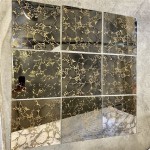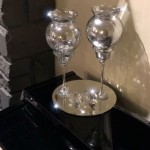What's the Scientific Name for a Mirror Image?
There isn't one single scientific name for a mirror image, as the concept applies across various scientific disciplines, each with its own specific terminology. The phenomenon of "mirror-imageness" relates to concepts like symmetry, chirality, and enantiomerism, depending on the context.
Key Concepts Related to Mirror Images
Understanding a mirror image necessitates exploring several key concepts:
1. Reflection
In physics and optics, a mirror image is the result of reflection. Light rays emanating from an object encounter a smooth, reflective surface and bounce back, creating a virtual image that appears behind the mirror. This reflection adheres to the laws of reflection, where the angle of incidence equals the angle of reflection.
2. Symmetry
In geometry, the concept most closely related to a mirror image is reflectional symmetry, also known as bilateral symmetry or mirror symmetry. An object possesses reflectional symmetry if it can be divided into two identical halves by a plane, with one half being the mirror image of the other.
3. Chirality
In chemistry, chirality describes a property of molecules. A chiral molecule is non-superimposable on its mirror image, similar to how a left hand and right hand are mirror images but cannot be perfectly aligned. This "handedness" plays a crucial role in molecular interactions and biological activity.
4. Enantiomers
Pairs of chiral molecules that are mirror images of each other are called enantiomers. These molecules have the same chemical formula and connectivity of atoms, but differ in their spatial arrangement. They often have different physical properties, such as the direction they rotate polarized light, and different biological activities.
5. Diastereomers
Diastereomers are stereoisomers that are not mirror images of each other. While enantiomers have opposite configurations at all chiral centers, diastereomers differ in the configuration of at least one, but not all, chiral centers.
6. Optical Activity
Chiral molecules exhibit optical activity, meaning they rotate the plane of polarized light. Enantiomers rotate polarized light in equal but opposite directions. A molecule that rotates polarized light clockwise is labeled as (+)- or dextro-rotatory, while a molecule that rotates it counterclockwise is labeled as (-)- or levo-rotatory.
7. Racemic Mixture
A racemic mixture contains equal amounts of both enantiomers of a chiral molecule. Because the opposite rotations of polarized light by each enantiomer cancel out, a racemic mixture exhibits no net optical activity.
Exploring Mirror Images in Different Scientific Fields
The concept of mirror images manifests differently across scientific disciplines. In physics, mirror images are explored through the reflection of light and wave phenomena. Geometric optics utilizes ray diagrams to analyze image formation in mirrors, while wave optics considers the interference and diffraction of light waves upon reflection.
Chemistry delves into the implications of chirality in molecular structure and reactivity. Pharmacology and biochemistry study how the different enantiomers of drugs can have drastically different effects in biological systems. For example, one enantiomer might have therapeutic benefits while its mirror image might be toxic. This understanding is critical for drug development and safety.
Mathematics uses group theory and symmetry operations to analyze mirror images and reflections. This branch of mathematics provides a formal framework for understanding the relationship between an object and its reflection. Crystallography, a branch of chemistry and physics, employs symmetry operations to understand the arrangement of atoms in crystalline solids, where mirror planes play a crucial role.
In biology, bilateral symmetry—the type of symmetry often associated with mirror images—is prevalent in the animal kingdom. Many animals, including humans, exhibit external bilateral symmetry. This external symmetry often reflects internal symmetries in organ arrangement.
Understanding the concept of mirror images requires considering the specific scientific context. While reflection and symmetry provide the foundational understanding, chirality and enantiomerism add further complexity in chemistry and its related fields. The diverse scientific disciplines each explore specific aspects of mirror images, revealing complex interactions and behaviors relevant to their respective areas of study.
Other Considerations
Other fields such as computer graphics and image processing utilize algorithms to create and manipulate mirror images. These techniques find applications in areas like facial recognition and image editing software. Additionally, psychology and neuroscience explore the cognitive processing of mirror images and how the brain perceives and interprets reflections.
What Is A Flat Mirror Called In Scientific Terms Quora
What Is A Flat Mirror Called In Scientific Terms Quora

Concave Mirrors And Convex Image Formation Ray Diagram

Concave Mirror Image Formation Ray Diagrams Conditions Mechanism

Convex Mirror Uses Of Definition Equation

Draw The Shape Of Diffe Types Mirrors And Lenses Label Them Homework Study Com

Plane Mirror Uses Properties Definition Focal Length Diagram

Draw A Mirror Image Structure For The Given Molecule Is Enantiomer Of Original Homework Study Com

Convex Mirror Uses Of Definition Equation

Concave Mirrors And Convex Image Formation Ray Diagram








